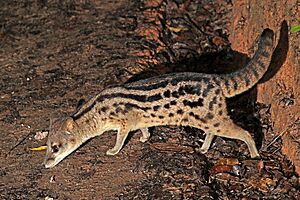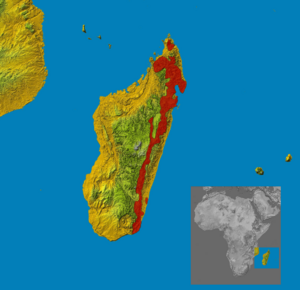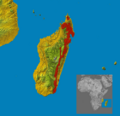Malagasy civet facts for kids
Quick facts for kids Malagasy civet |
|
|---|---|
 |
|
| at Ranomafana National Park | |
| Conservation status | |
| Scientific classification | |
| Genus: |
Fossa
|
| Species: |
fossana
|
 |
|
| Malagasy civet range | |
| Synonyms | |
|
Viverra fossana Müller, 1776 |
|
The Malagasy civet is a cool animal found only on the island of Madagascar. It's also called the striped civet or fanaloka. This unique creature is the only species in its group, called Fossa.
Malagasy civets are small mammals. They are about 47 centimetres (19 in) (18.5 inches) long, not counting their tail. Their tail adds another 20 centimetres (7.9 in) (8 inches). These civets usually weigh between 1.5 to 2.0 kilograms (3.3 to 4.4 lb) (3.3 to 4.4 pounds). They live in the tropical forests of Madagascar. Malagasy civets are active at night. They eat small animals, insects, and even bird eggs. Sadly, the Malagasy civet is listed as a Vulnerable animal. This means its population is decreasing.
The name fanaloka comes from the Malay word pelanduk. This word means "mousedeer". People think the name was used because the civet and mousedeer are similar in size.
Contents
What is a Malagasy Civet?
The Malagasy civet is a small, shy animal. It has a short coat that is greyish-beige or brown. You can easily spot it by its dark black stripes. These stripes run horizontally from its head to its tail. On its bushy tail, the stripes wrap vertically around it. Near its belly, the stripes turn into spots. Its legs are short and very thin.
Male civets can weigh up to 1.9 kilograms (4.2 lb) (4.2 pounds). Females are a bit lighter, weighing up to 1.75 kilograms (3.9 lb) (3.8 pounds). It is the second largest meat-eating animal in Madagascar. The fossa is the largest. Sometimes, people might confuse it with the small Indian civet.
Malagasy Civet Behavior
Malagasy civets are mostly active at night. They are known to be very shy and secretive. Scientists are not sure if they live alone or in pairs. Living in pairs would be unusual for animals in their family.
These civets are not very good at climbing trees. They prefer to stay on the ground, often in ravines. They have a varied diet. They eat small animals like mammals, birds, reptiles, and amphibians. They also enjoy insects, aquatic animals, and eggs they find in birds' nests.
Their sounds can be like crying or groaning. They also make a sound like "coq-coq." If they live in pairs, a male and female will protect a large area as their home. This territory can be about 50 hectares (120 acres) (123 acres). In winter, they can store fat in their tails. This fat can make up 25% of their total body weight!
Life Cycle and Reproduction
The Malagasy civet's mating season is usually from August to September. After mating, the mother carries her baby for about three months. This is called the gestation period. Usually, only one baby is born at a time.
When born, the young civets are quite developed. They weigh around 65 to 70 grams (2.3 to 2.5 oz) (2.3 to 2.5 ounces). They drink their mother's milk for about two to three months. They leave their parents when they are about one year old. In zoos, Malagasy civets can live for about 21 years.
Where Malagasy Civets Live
You can find Malagasy civets in the lowland and rainforest areas of eastern and northern Madagascar. They also live in humid, isolated forests. For example, they are found in Amber Mountain National Park. You can also find them further north in the drier forests of Ankarana Reserve.
They can live from sea level up to 1,600 metres (5,200 ft) (5,200 feet) high. However, they are most common below 1,000 metres (3,300 ft) (3,300 feet) above sea level.
Conservation Status
The Malagasy civet is listed as a Vulnerable animal by the International Union for Conservation of Nature (IUCN). This means their numbers are going down.
Many things threaten these civets. One big problem is deforestation, which means their forest homes are being cut down. They are also hunted by people. Making charcoal and logging also destroy their habitat.
Another threat comes from introduced species. These are animals brought to Madagascar by humans. Dogs, cats, and small Indian civets compete with the Malagasy civet for food. Dogs might also hunt and eat them. Because of these threats, the Malagasy civet's home is now much smaller. They only live in scattered patches of forest.
Images for kids




